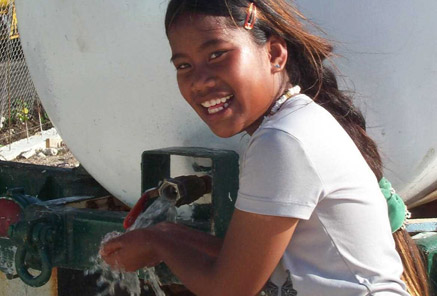Republic of the Marshall Islands
Geography
Land Use
People
Economy
Water Statistics
|

Status of Water Resources
For the RMI as a whole, the supply of natural freshwater is severely limited. The primary source of freshwater is rain which (due to the low elevation of the atolls and islands) soaks directly into the soil and disperses into saltwater which permeates atoll subsoils. In some favourable locations some of the freshwater may accumulate in a Ghyben-Herzberg lens which floats on the saltwater below and can be accessed with wells (SOPAC 1996).
There is a rainfall gradient, with heavier rainfall in the southern atolls and islands (typically in excess of 100 inches per annum) and less rainfall in the northern atolls and islands (typically less than 100 inches per annum).
Problems with Water Resources and Associated Environment Issues
The major issues and concerns related to overall water management in the RMI are as follows:
- Insufficient quantity
Various studies have identified that Majuro’s current 36.5 million gallon reservoir capacity as insufficient and should be doubled in order to help meet growing demand. Moreover, in the Majuro water reticulated supply system there is significant leakage and theft which may be contributing to up to 50 percent wastage of water.
- Challenged public utilities
The two main water utilities, MWSC on Majuro and Kajur on Ebeye, continue to face great challenges in delivering quality water and services on a consistent and reliable basis. On Ebeye an added complication stems from the fact that power problems (power is also run by Kajur) directly create water supply problems. On both Majuro and Ebeye, capacity development and training remain critical for the improvement of financial and operational management.
- Contamination
Contamination and pollution are real and present threats to water resources everywhere, including in the water systems, in the groundwater (especially in urban areas), in household catchments, and in coastal areas. For Outer Island households, the Environmental Protection Authority (EPA) has dramatically increased its water quality testing in recent years and has revealed that a high percentage of home water catchments are contaminated, this also is the case in the urban centres. This, in turn, supports the data that show a high and increasing prevalence of water-borne diseases).
- Weak conservation and demand management
Public attitude and awareness on water conservation, reuse, and related issues is poor. Campaigns for water conservation are few and far between, even during the dry season. Moreover, there is virtually no promotion of water efficient appliances. The EPA’s community water monitoring program has proven to be an effective face-to-face way of educating various communities and this presents an opportunity for further improvement.
- Non-integrated management
There is fragmentation of authority and responsibility over water issues, with no single organisation or entity serving to pull together information and harmonise efforts. There exists no national level water committee (or similar entity) and community level coordination is just starting. The RMI has no information exchange system on water resources.
Diagnostic Report
Demonstration Proposal
Hot Spot Analysis
Information on this page obtained from Integrated Water Resources Management programme's Diagnostic Reports (SOPAC 2007)
© 2024 SPC Water, Sanitation and Hygiene. All rights reserved.